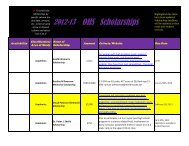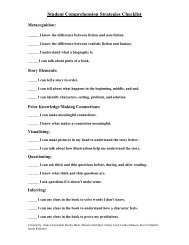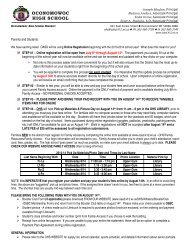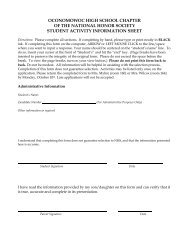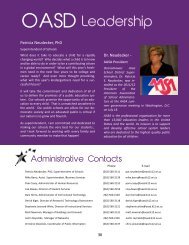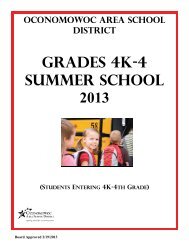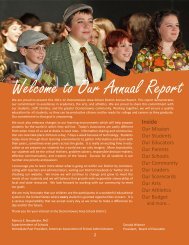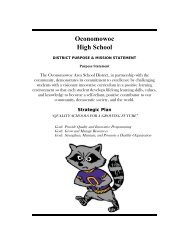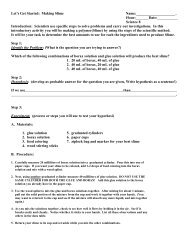Four-Year-Old Kindergarten - Oconomowoc Area School District
Four-Year-Old Kindergarten - Oconomowoc Area School District
Four-Year-Old Kindergarten - Oconomowoc Area School District
You also want an ePaper? Increase the reach of your titles
YUMPU automatically turns print PDFs into web optimized ePapers that Google loves.
Welcome to <strong>Four</strong>-<strong>Year</strong>-<strong>Old</strong> <strong>Kindergarten</strong><strong>Oconomowoc</strong> <strong>Area</strong> <strong>School</strong> <strong>District</strong>A Parent Preview of what you and your child canexpect in <strong>Four</strong>-<strong>Year</strong>-<strong>Old</strong> <strong>Kindergarten</strong>A Word About <strong>Four</strong>-<strong>Year</strong>-<strong>Old</strong> <strong>Kindergarten</strong>What will your child be learning this year?How can you help your child be successfulin school? These are important familyquestions! This brochure was created toexplain the major academic expectationsheld by our <strong>District</strong> for students in four-year-old <strong>Kindergarten</strong>. You’ll also learnmore about homework, how our teachersmeasure learning progress, home/schoolcommunications, common behaviors for 4– and 5-year-olds and much more.Welcome to <strong>Four</strong>-<strong>Year</strong>-<strong>Old</strong> <strong>Kindergarten</strong>. Together, we can help your child reach theirfull potential and get the most out of their <strong>Four</strong>-<strong>Year</strong>-<strong>Old</strong> <strong>Kindergarten</strong> experience.AcademicExpectationsAs you review this brochure,please note that we can’tinclude everything your childwill be learning due to spacelimitations. Please contact yourchild’s teacher at any timeduring the school year formore information.Measuring your Child’sLearning Progress• Teacher observations• Daily classroom activities• Report cards• Individual student portfoliosWays You Can Get Involved• Share your talents at school;your participation iswelcome and appreciated!• Contact your child’s teacherwith questions or concerns• Attend Parent/TeacherConferences• Volunteer in your child’s classroom and takepart in class field trips• Participate in classroom parties and in homeprojects• Share information about your career orhobbies with your child’s classroom• Attend school-sponsored programs• Join the Parent Teacher Organization orAssociationSupport Your Child’s Learning:1. See that your child comes to school rested,well fed and ready to learn2. Talk with your child about the day’s activities3. Take an interest in what your child is learning;recognize your child’s achievement andprogress4. Read to your child daily5. Engage your child in learning games andconversations6. Reinforce classroom and school rules7. Work in cooperation with school and yourchild’s teachers8. Review classroom and school communicationsRevised August 2011
Welcome to <strong>Four</strong>-<strong>Year</strong>-<strong>Old</strong> <strong>Kindergarten</strong>Page 2Some developmental characteristics displayed by many 4-year-olds• Build complex block structures• Dress and undress without assistance; brush teethand comb hair; spills rarely with cup or spoon• Lace shoes, but cannot yet tie• Enjoy manipulating play objects that have fineparts• Draw combinations of simple shapes; drawpersons with at least four parts and objects thatare recognizable to adults• Express emotions through facial gestures, and canread others for body cues; copy behaviors of olderchildren or adults• Learn new vocabulary quickly if related to ownexperience• Usually speak in five to six word sentences• Like to sing simple songs: know many rhymes andfinger plays• Begin cooperative play• Show great ability to control intense feelings likefear or anger• Show pleasure in having and being with friendsSome developmental characteristics displayed by many 5-year-olds• Manage a toothbrush, complete some picturepuzzles (small motor control)• Ride a two-wheeler and learn simple dance steps(large motor control)• Display independence skills, such as dressing andfeeding themselves• Move toward the self-direction and self-controlrequired of school-age children• Persist longer at tasks and work until theycomplete project• Talk about distant places like a farm or fire station• Ask questions for practical reasons: What is this?What do I do with this?• Enjoy friends and may have one or more closefriends• Have defined preferences, such as choice of toys,clothes, and television programs• Enjoy the kindergarten setting and is able to domanipulative learning activities that will fostermath, language, science, and artistic skills• Talk meaningfully about tomorrow and yesterdayThese excerpts from Understanding Your Child Birth to Sixteen by David Elkind and Your Five <strong>Year</strong> <strong>Old</strong>: Sunny and Serene byL. Bates Ames and Francie L. IlgWhen students complete <strong>Four</strong>-<strong>Year</strong>-<strong>Old</strong> <strong>Kindergarten</strong>, they should be able to:Communication Arts and Reading• Enjoy stories• Explore books beginning to end• Participate in large group activities• Follow directions• Demonstrate proper book care and librarycheckoutWriting• Include details in drawing• Identify letters in their name• Print nameMathematics• Recognize colors• Rote count accurately• Recognize the four basic shapes: square,circle, triangle and rectangle• Count objects with a 1-to-1 correspondence• Explore geometry• Explore measurement• Recognize numbers 0 to 10• Recognize, copy and extend patterns• Use math vocabulary: more/less, heavier/lighter,next to/behind
(When students complete <strong>Four</strong>-<strong>Year</strong>-<strong>Old</strong> <strong>Kindergarten</strong> continued)Page 3Social Studies• Explore social studies concepts• Contribute to discussion and activities• Follow school and classroom rules and routinesScience and Health• Explore science concepts• Demonstrate self-help skillsMotor Skills• Throw and catch a playground ball• Kick a stationary playground ball• Use a tripod pencil grip• Use scissors appropriatelySocial and Emotional Development• Work cooperatively with others• Demonstrate self control• Respect self, others and property• Enjoy friendsDoes 4K Positively Impact Children’s Development?(from the Wisconsin Department of Public Instruction)Presently, Wisconsin does not have the data tocorrelate student performance on statewide tests withpast 4K participation. We can, however, explore theimpact of 4K participation in this state by reviewingdata from one national study that included Wisconsinand from several Wisconsin school districts thatconducted their own studies.Key findings are summarized below:The National Center for Early Development andLearning study of State-Wide Early Education Programsconducted a study that examined variations amongprekindergarten programs in five states(Massachusetts, New Jersey, Texas, Washington, andWisconsin). The study also related program variationsto child outcomes at the end of prekindergarten andin kindergarten.In Wisconsin, one classroom in each of 100 4K siteswas randomly selected to participate in the studyduring the fall of 2003. Within each classroom, fourchildren (two boys and two girls) were randomlyselected, pending parental consent, resulting in asample of 400 Wisconsin 4K students. Data collection,including direct assessment of children’s earlyacademic skills, took place in fall 2003 and spring2004. Key findings are summarized below:• In the spring of the 4K year, Wisconsin 4Kstudents were above the national average onthree of the four academic skills assessmentshaving standardized national averages of 100,and scored particularly high on a letter-wordidentification subtest.• Wisconsin students showed growth on all tenacademic skills assessments between thepre-test and the post-test administrations.Gains were particularly noteworthy in students’ability to write their names and identify letters.• Academic assessment information categorizedby students’ economic status showed that theperformance of both poor and non-poor studentsimproved between the fall 2003 pre-test and thespring 2004 post-test on all measures.• Wisconsin 4K students improved on all ninedimensions in language and literacy. Pre-testratings on the 1-5 scale ranged from a low of1.53 to a high of 2.90, and post-test ratingsranged from a low of 2.22 to a high of 3.75.
<strong>Oconomowoc</strong> <strong>Area</strong> <strong>School</strong> <strong>District</strong>Curriculum & Instruction OfficeW306N7077 Brown Street<strong>Oconomowoc</strong> WI 53066-1197Phone: 262-560-2116Stephanie Leonard-WitteDirector of Curriculum & InstructionOASD Elementary <strong>School</strong>sGreenland Elementary 560-8100440 Coolidge StreetIxonia Elementary 560-8400N8425 North Street, IxoniaMeadow View Elementary 560-8000W360N7077 Brown StreetPark Lawn Elementary 560-8200300 Park Lawn StreetVisit our website:www.oasd.k12.wi.usSummit Elementary 560-83001680 Valley RoadWays we keep in touchHome/<strong>School</strong> Communications• <strong>District</strong> Web site—www.oasd.k12.wi.us• Open House in September• Field trip notices/permission forms• Parent/Teacher Conferences• Parent/Teacher notes, calls and e-mails• Classroom newsletters• Monthly on-line school newsletter• <strong>District</strong> school calendarWe welcome your partnership in helping yourchild achieve success in school. By working andtalking together, we can create a very positivelearning environment. Each staff member hasmail and e-mail. Please feel free to contact yourchild’s teacher or the office with any questions orconcerns.





